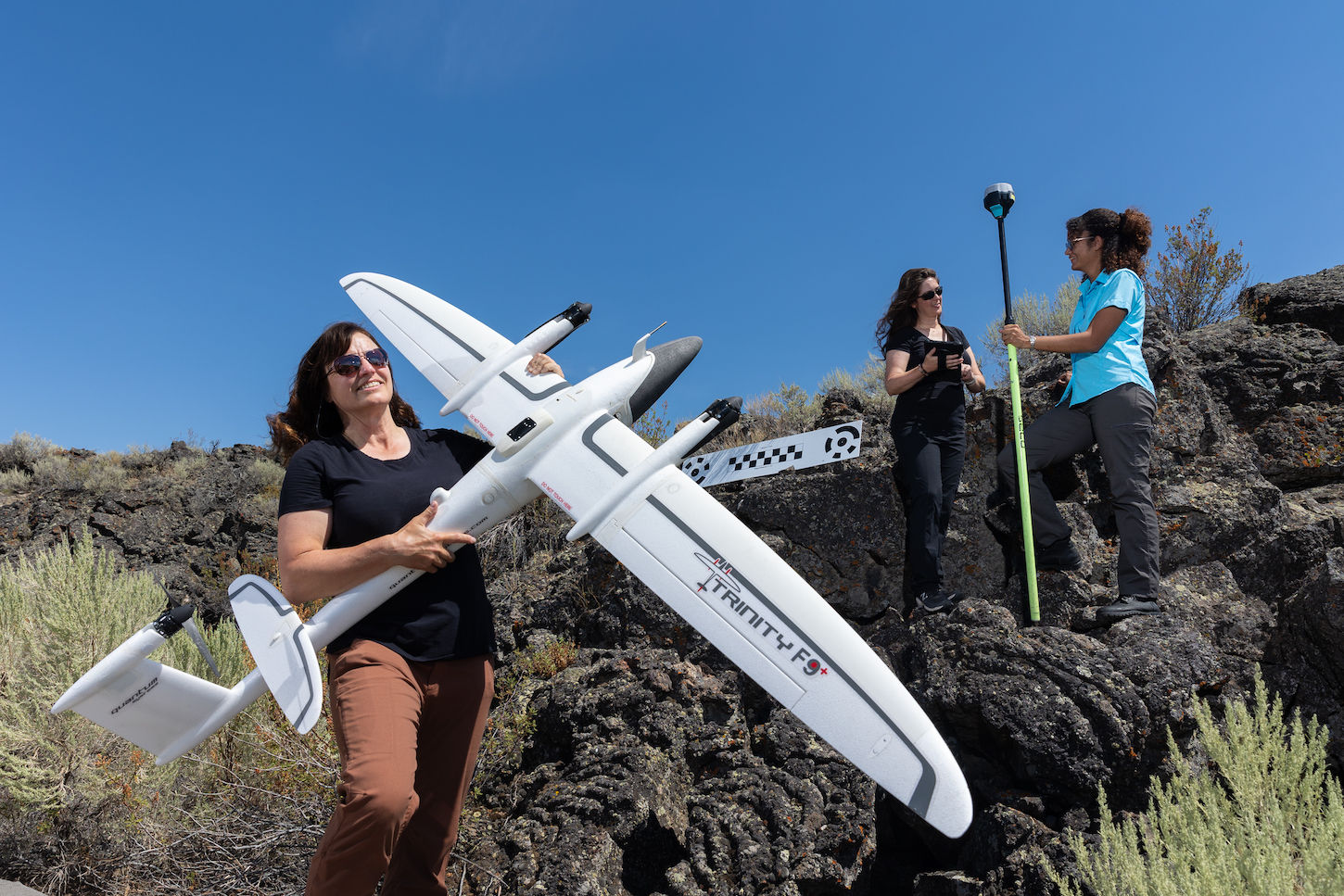Mapping the Moon: Research Tackles Volcanoes on Other Worlds, Lunar Navigation
September 18, 2023

Two Idaho State University professors hope the volcanic features around East Idaho can answer some questions about their otherworldly counterparts.
Over the next three years, Shannon Kobs Nawotniak and Donna Delparte, professors of geosciences, and their team of researchers will be working in, around, and on the volcanoes that formed in the wake of the Yellowstone hotspot’s passage through the eastern Snake River Plain millions of years ago.
“The volcanoes of the eastern Snake River Plain have the same lava type and eruption style of volcanoes on the Moon and Mars,” said Kobs Nawotniak, a specialist in volcanology and planetary exploration. “And in many cases, the volcanoes look almost identical, though smaller in scale thanks to the different gravities.”
They hypothesize the volcanoes will be able to tell them more about the history of geologic change on the surface and underneath the region. Additionally, they postulate the research techniques employed by the team will be usable by astronauts on future missions to study the same forces of change on the Moon and beyond.
The group will make their way to the eruptive vents just north of Mud Lake to test new ways of using field equipment to understand the role of water in the features, travel to Craters of the Moon National Monument and Preserve to collect high-resolution imagery and surface scans, and go to caves and lava tubes that dot the landscape of East Idaho to get three-dimensional laser scans. Kobs Nawotniak notes that their work will help in future exploration of the Moon by allowing them to gather similar measurements here in Idaho, including building one of the most comprehensive 3D catalogs of lava tube scans on Earth.
“Unmanned aircraft systems (UAS) will allow our research team to map the complexity of volcanic surfaces, identify geologic features, and trace the influence of water,” said Delparte, a specialist in UAS and remote sensing technology. “Onboard our UAS, we will use advanced sensor systems, such as LiDAR, to create these incredibly detailed 3D surface scans. These tools will help us train the next generation of scientists on how to use the outputs of this technology to interpret volcanic features on the moon.”
“Actual space exploration has inherent dangers and expenses,” Kobs Nawotniak said. “We can ensure future success by dialing things in here on Earth, thereby reducing the overall costs. In addition, we’ll learn more about the volcanic history of Idaho and, by extension, the Moon.”
Besides providing some clues to the makeup of lunar volcanic features and those found elsewhere in the cosmos, Kobs Nawotniak will be using the same navigational techniques for their work in the field as the Artemis III astronauts are planning to use when they visit the Moon in 2025.
“GPS doesn’t exist on the Moon, so the plan right now is for the Artemis III astronauts to navigate using printed map books and dead reckoning, using lunar craters as landmarks,” said Kobs Nawotniak. “We will conduct our field research using the same styles of maps, coupled with hidden GPS units for later corrections, to study where and how positioning errors will emerge and how to mitigate them.”
Kobs Nawotniak says the current plan from NASA has the Artemis III astronauts staying relatively close to their lander, so it’s not a case of worrying that astronauts will get lost on the lunar surface.
“In the geosciences, it really matters where each sample, each photo, is taken,” says Kobs Nawotniak, “Correct locations are essential to good field science.”
The research by Kobs Nawotniak and Delparte is funded by nearly $750,000 from the Idaho NASA Established Program to Stimulate Competitive Research. The grant will support the work of three graduate students and several undergraduate students on the project and includes paid internships to work with Kobs Nawotniak’s collaborators at the NASA Goddard Space Flight Center in Maryland.
“I'm incredibly thrilled to begin my studies as a graduate student at ISU and participate in such important research,” said Delgado Maisonet, a graduate student from Puerto Rico. “I'm so grateful for having the opportunity to study Idaho’s volcanoes in support of future NASA missions to the Moon.”
This is the latest in a string of projects from Kobs Nawotniak with ties to NASA. She recently served as a member of NASA’s Joint EVA Test Team (JETT) 3. The JETT 3 Team was responsible for planning a series of lunar-relevant simulation space walks for astronauts training for the Moon and supporting the simulated missions from the Mission Control facilities at NASA’s Johnson Space Center. She was also the Deputy Principal Investigator for the Biologic Analog Science Associated with Lava Terrains (BASALT) project, Geology Co-Lead for Field Investigations to Enable Solar system Science and Exploration (FINESSE) project, and a co-investigator on the Systematic Underwater Biogeochemical Science and Exploration Analog (SUBSEA).
“It’s an honor to continue to be part of NASA’s efforts to return to the Moon and, ultimately, keep going to Mars,” said Kobs Nawotniak. “There are so many exciting questions to answer out there, and it’s a privilege to use our own Idaho volcanoes to help launch ourselves into the future… pun intended!”
For more information on ISU’s Department of Geosciences, visit isu.edu/geosciences.
Categories:
